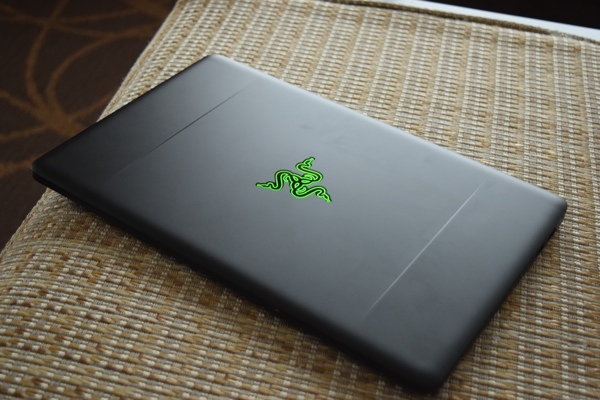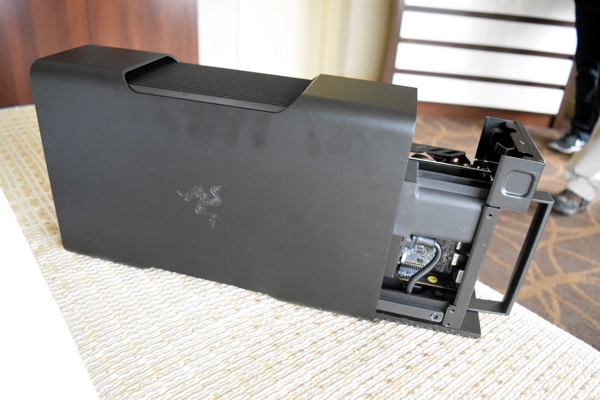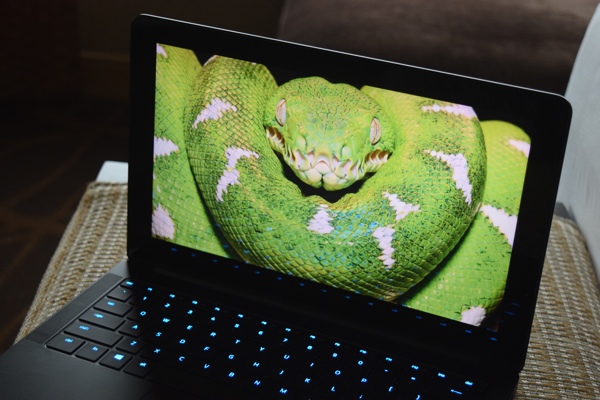Razer Blade Stealth Is a Killer $999 Ultrabook
LAS VEGAS — Just when I thought Razer couldn't shave another ounce off of its suite of already ridiculously slim laptops, the company goes and proves me wrong with its latest creation, the Blade Stealth. Weighing a scant 2.75 pounds, the Stealth packs a 4K display, Core i7 CPU and colorful Chroma keyboard for a very affordable $999.
The weight loss is a result of Razer ditching its discrete graphics in favor of an Intel integrated chip. But fear not, gamers, Razer is also launching its own version of a graphics amplifier dubbed the Core which will be available sometime in the first half of 2016.
Razer let me have some quality time with both systems prior to CES, and it looks like the company has a pair of certified winners on its hands.
MORE: CES 2016 Readers' Choice Awards
Design
Wow, just wow. The Blade Stealth is absolutely gorgeous. Swathed in obsidian aluminum accented by the glowing green tri-snake emblem on its lid, this beauty is the spitting image of its bigger brothers, the Blade and the Blade Pro. The laptop measures 12.6 x 8.1 x 0.5 inches and weighs 2.75 pounds. To put things in perspective, that's lighter and slimmer than both the Dell XPS 13 (2.9 pounds, 11.98 x 7.88 x 0.33-0.6 inches, Apple MacBook Air (2.96 pounds, 12.8 x 8.9 x 0.11-0.68 inches) and the Lenovo Yoga 900 (2.8 pounds, 12.75 x 8.86 x 0.59 inches).
The Razer Core is also a looker. Adhering to the dashing company uniform, the graphics amplifier's chassis is constructed from the same aircraft-grade aluminum as the notebooks. Measuring 8.6 x 4.13 x 13.38 inches, the Core is a more compact proposition compared to the Alienware's Graphics Amplifier (6.8 x 7.3 x 13.1 inches). The amps do have something in common, however: their use of custom lighting. But the Alienware's amp backlit zone only consists of the small alien head logo compared to the Core's interior which you can view through the large window, allowing the light to pour into the room.
MORE: The Best Gaming Laptops
Sign up to receive The Snapshot, a free special dispatch from Laptop Mag, in your inbox.
Display
The Stealth's good looks don't stop at the exterior. Beneath that black aluminum lid lies a 12.5-inch 4K (3840 x 2160) touch panel. The colors were vibrant particularly when it came to the greens and blues. According to Razer, the display measures 100 percent of the Adobe RGB color gamut. For instance, when I looked at a high-resolution image of a snake, I could easily see every single scale as well the deep shadows cast from its massive coils.
MORE: Best Ultrabooks (Thin-and-Light Windows Laptops)
Keyboard
Instead of the usual trademark backlit green island-style keyboard, the Stealth is the first laptop with individually backlit keys. And thanks to Razer's Chroma technology, every key on the fullsize keyboard can be mapped in 1 of 16.8 million colors. Creative gamers can also take advantage of a multitude of lighting effects to create their own personal light show.
Specs/Pricing
Historically, Razer has been known for placing its priority on performance, which makes for an ultra premium system with an equally premium price tag. The company is issuing a direct challenge to the likes of Dell and Apple, offering the same premium specs, but at an affordable price.
The base model of the Blade Stealth starts at $999 and features a 2.5-GHz Intel Core i7-6500 dual core processor, 8GB of RAM, a 128GB PCIe SSD and Intel HD Graphics 520 GPU. For the same price, you can get a 13-inch MacBook Air with an Intel Core i5 CPU, 4GB of RAM, a 128GB Flash Storage and an Intel HD Graphics 6000.
MORE: The Best Laptops for Every Need
Core
Since the Blade Stealth lacks discrete graphics, it will rely on the Core to do its heavy lifting. Similar to most graphic amplifiers on the market, the Core is a bring-your-own-GPU situation. That means you'll have to fork out some extra cash for a desktop graphics card. But Razer has yet to announce the pricing on the Core, so there's no telling how this will affect your bottom line.
In practice, the Core is easier to use than the Alienware's Graphics Amp. For example, putting in the graphics card is as simple as pulling out the chamber, installing the component and tightening a screw to secure it in place. Once, the GPU is in place, you slide the chamber back in and you're ready to go. I've encountered some difficulty prying open the Alienware's lid, but once I accessed the device's interior, it was relatively easy to place the card.
The bigger difficulty lies in actually getting the accompanying Alienware laptop to recognize the amp once its attached. There have been times during our testing where we had to consistently detach and reattach the amp via the proprietary port to access the desktop graphics card. With the Core, you simply plug into the Blade Stealth via a USB-C port. In the demo, the computer took about 3 to 4 seconds to switch over. However, the system did not handle my unplugging and plugging it in too quickly.
Bottom Line
Razer has spent the last few years honing its craft, creating gaming laptops that could satisfy even the pickiest gamer. However the prohibitively high price tag kept all but the most deep-pocketed players from owning a system. With the Blade Stealth's affordable price, Razer is not only expanding its consumer base, it's sending a direct challenge to ultraportable and gaming laptop manufacturers. In 2016, it's game on.

Sherri L. Smith has been cranking out product reviews for Laptopmag.com since 2011. In that time, she's reviewed more than her share of laptops, tablets, smartphones and everything in between. The resident gamer and audio junkie, Sherri was previously a managing editor for Black Web 2.0 and contributed to BET.Com and Popgadget.




